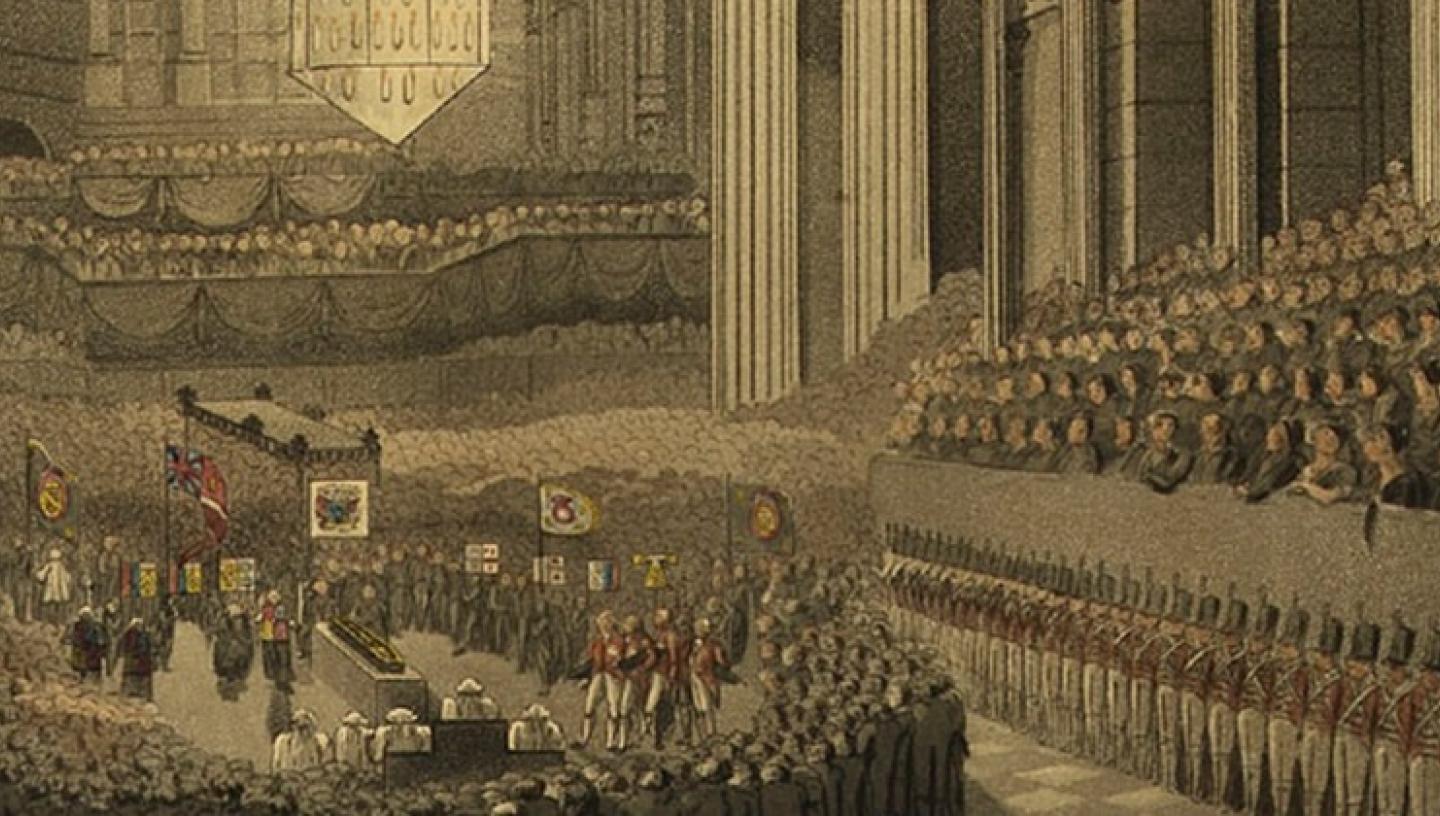
12 Jun 2019
In this blog we recall how the nation bid farewell to Nelson and look at the life of the Garter King of Arms, Sir Isaac Heard (1730-1822), who organized the procession and ceremony.
By Stawell Heard, Librarian, Acquisitions and Cataloguing
Visit the Caird Library and Archive
On Wednesday, 8 January 1806, after three days of lying in state in the Painted Hall at Greenwich, the coffin containing the mortal remains of Admiral Lord Horatio Nelson was transferred onto a state barge on the River Thames and began the journey, as part of a flotilla with other barges, up the river to Whitehall. Nelson, the hero of Trafalgar, was being accorded the honour of a state funeral. The weather was fine but breezy. Escorting the flotilla on the choppy river that day were a number of Royal Navy escort vessels from which there emanated the dull thud of their minute guns. In the fourth barge (the one behind Nelson), was the chief mourner, Admiral Sir Peter Parker, and lining the river banks and bridges were crowds of onlookers who had come to see the procession and to mourn Nelson.
When the flotilla arrived at Whitehall, the coffin was unloaded and conveyed (by eight seamen from the Victory) to the Admiralty building, where it was to reside overnight. Following the coffin, in front of the chief mourner and two admirals, was the Garter King of Arms (the chief herald). Behind them were a Royal Navy captain, six admirals and Nelson’s servants.
Overnight, in the streets through which the procession was to pass, spectators began to gather and, as night became day, faces appeared at the windows of the buildings. The principal attendees, including, mounted on horseback, Their Royal Highnesses the Duke of Cambridge and the Duke of Kent, gathered in Hyde Park and began to make their way to the Admiralty. Around eleven o’clock they passed through St James’s Park.
The funeral service and interment were to take place in St Paul’s Cathedral in the City of London. The coffin was conveyed under a canopy in a funeral car adorned with heraldic devices. The Lord Mayor of London received the procession within Temple Bar and joined it between the Prince of Wales and the herald of arms. From here to St Paul’s the crowd of spectators clapped their hands.
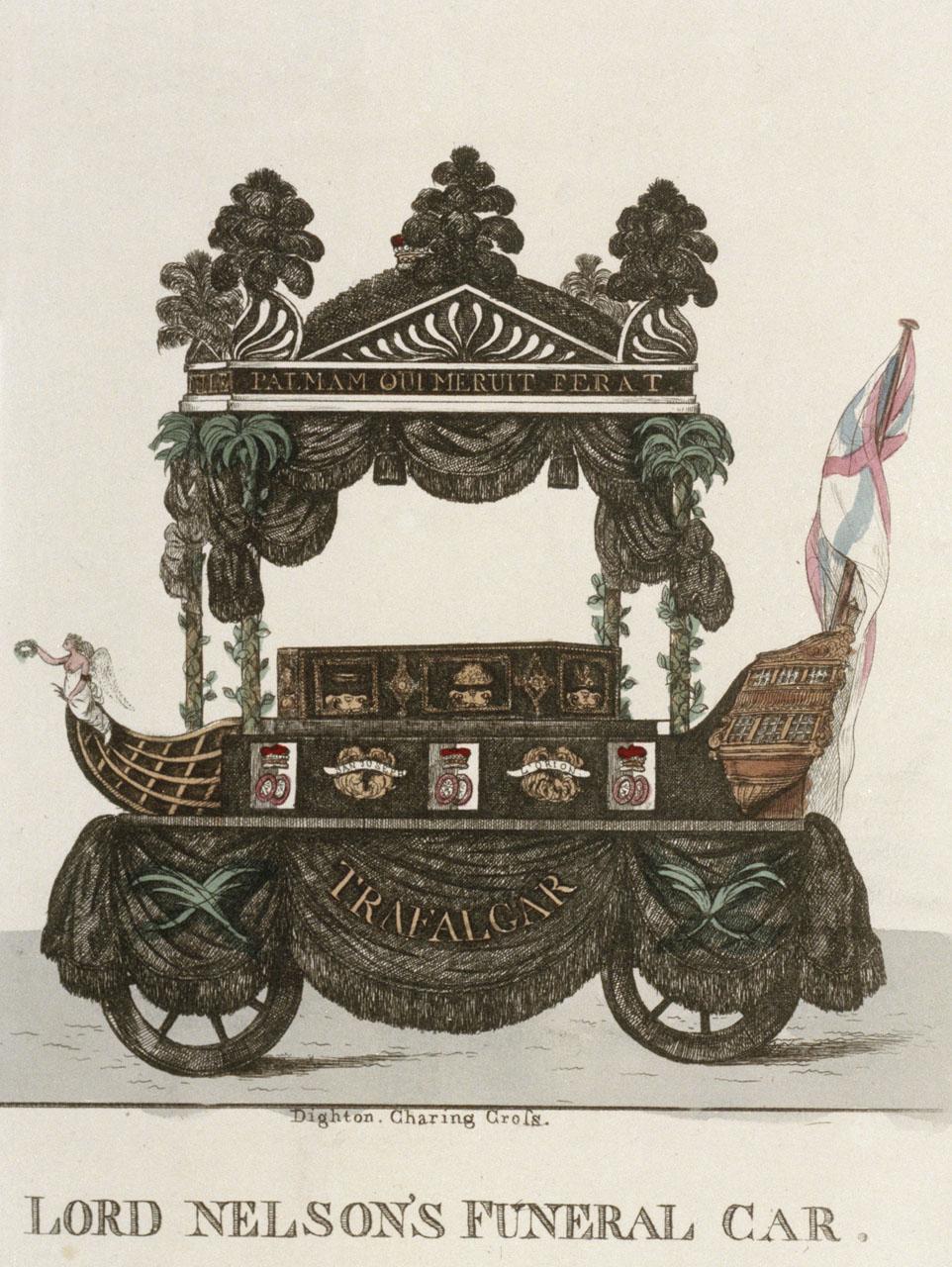
When the funeral car arrived at St Paul’s, there was a small hiccup. The sliders required to lower the coffin were not where they should have been and it took almost 15 minutes before the coffin could proceed on its way into the cathedral, and the choir service begin. Psalms were sung and following this, at 5.33 p.m., the coffin was lowered into its grave. The Garter King of Arms proclaimed the style. A detailed account of the funeral procession and service is contained in Fairburn’s edition of the funeral of Admiral Lord Nelson (Caird Library ID: PBE9819) from which most of this account is drawn. This gives the words spoken by the Garter King of Arms as being close to the following:
‘Thus it has pleased Almighty God to take, out of this transitory life, unto his divine mercy, the most Noble, Lord Horatio Nelson, Viscount and Baron Nelson of the Nile, and of Burnham Thorpe, in the County of Norfolk, Baron Nelson of the Nile, and of Hilborough in the same county; Knight of the most Honourable the Order of the Bath; Vice-admiral of the White Squadron of the Fleet, and Commander in Chief of his Majesty’s ships and vessels in the Mediterranean; also Duke of Bronte in Sicily; Knight Grand Cross of the Sicilian Order of St. Ferdinand and of Merit: Member of the Ottoman Order of the Crescent; Knight Grand Commander of the Order of St. Joachim; and the Hero who, in the moment of victory, fell covered with immortal glory. Let us humbly trust that he is now raised to bliss ineffable, and to a glorious immortality!’
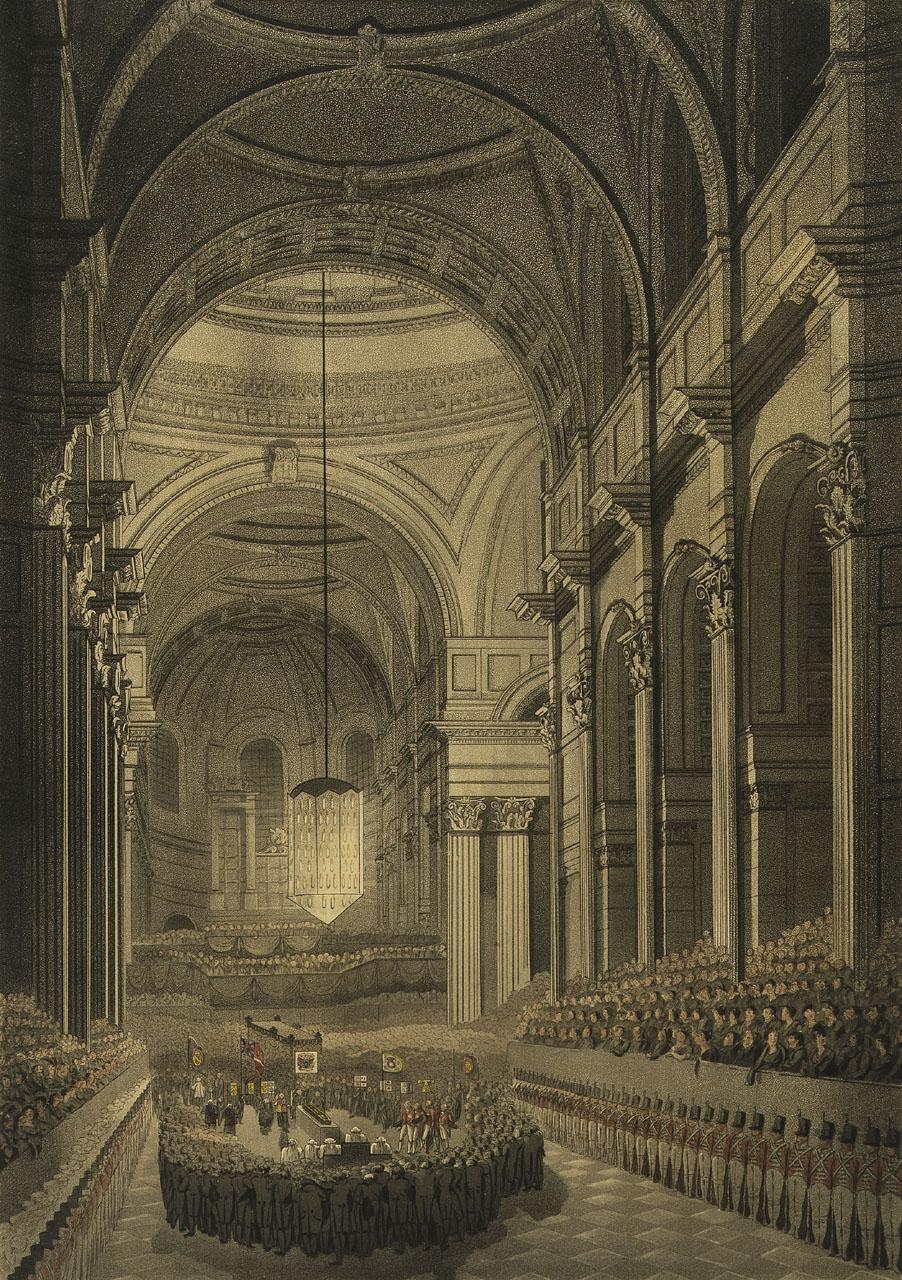
The Garter King of Arms, who was responsible for organizing the ceremonial aspects of the funeral, was, at this time, a family member of mine, Sir Isaac Heard. What is interesting about Isaac’s proclamation of the style on this day was that, by including the words ‘and the Hero who, in the moment of victory, fell covered with immortal glory’, he broke with tradition, but captured the nation’s mood.
Nor was he the only one to break with tradition. At this point in the ceremony, the seamen who had carried in the Victory’s flags should have laid them upon a table. Instead they tore a piece from one, and tore that piece into further pieces, which they kept as souvenirs.
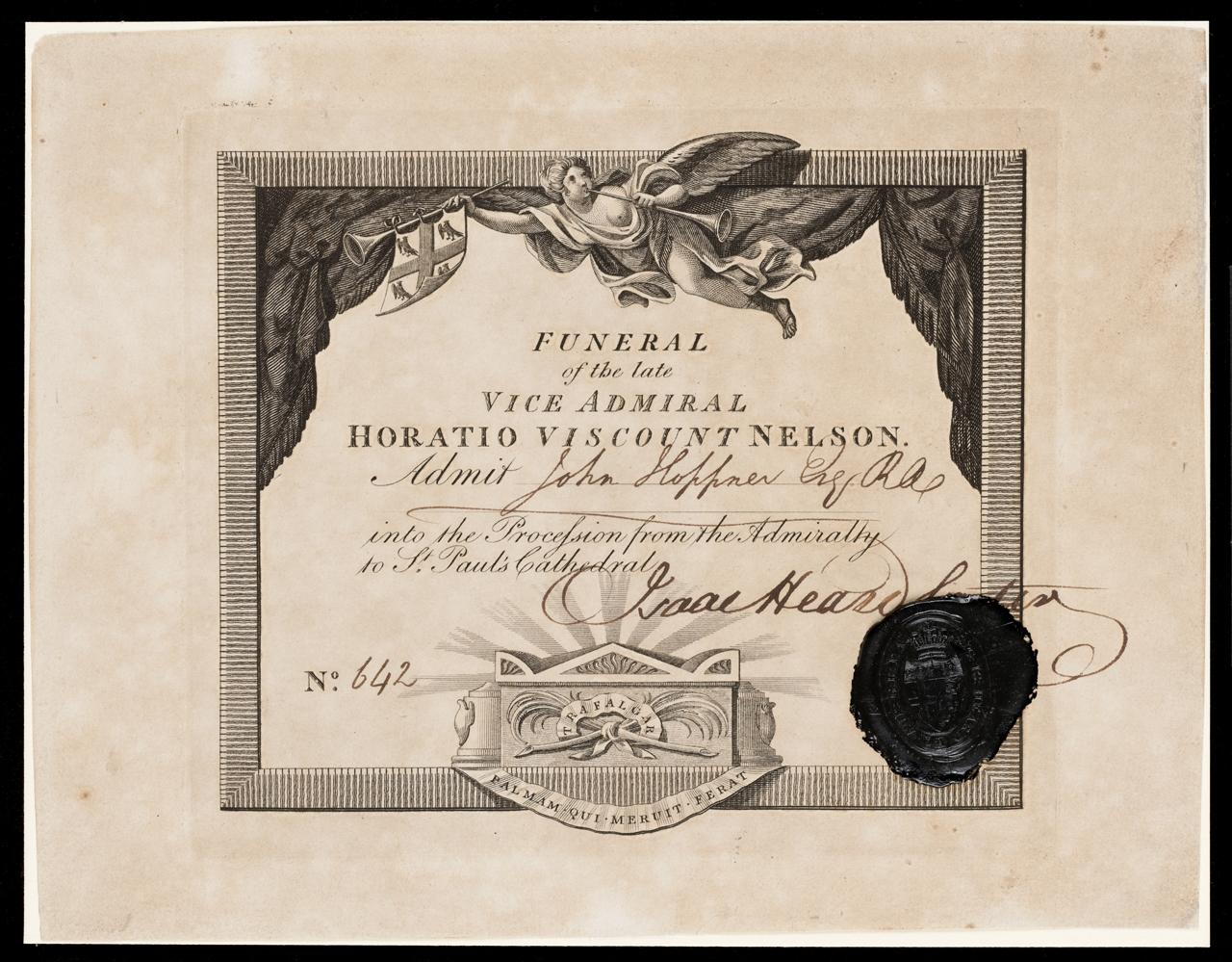
It was not the first state funeral which Isaac had organized, nor was it the first occasion on which he and Nelson had crossed paths. They were known to each other in life and had corresponded. Isaac’s position at the College of Arms meant that they had had official dealings in connection with Nelson’s titles.
Letters published in the seven-volume work The dispatches and letters of Vice Admiral Lord Viscount Nelson with notes by Sir Nicholas Harris Nicolas reveal dealings between Nelson and Isaac. This work was originally published in the 1840s (the Caird Library has several sets including an open-access copy, ID PBP5887/1-7). On 1 November 1799, Nelson wrote to Isaac:
‘I am not certain that I answered your congratulatory letter on my elevation to the Peerage – if not, I beg your pardon, and probably deferred it at the moment, in expectation of receiving the plan of the Arms you sent to Lord Grenville, but which has never reached me. I should be much obliged to you for them, but now I suppose the Ducal Arms of Bronté must have a place. If His Majesty approves of my taking the Title of Bronté, I must have your opinion how I am to sign my name.’
He proceeds to ask Isaac’s advice as to how he should wear ’the Pelises’ when he first meets the King, and where he should wear the ‘Aigrette’. ‘In my hat, having only one arm, is impossible, as I must have my hand at liberty’.
Who, then, was Isaac Heard, the long-serving chief herald who organized state funerals and advised peers on etiquette? Isaac was born in Ottery St Mary, Devon, on 21 December (new style) 1730. His three-times great-grandfather (and a mutual ancestor of mine) was John Heard of Wiltshire who, in 1579, migrated to County Cork in Ireland. Isaac’s grandfather (another Isaac) was a merchant from the town of Kinsale, County Cork, who later settled in Bridgwater in Somerset. Isaac was the eldest son of John and Elizabeth Heard. He attended Honiton Grammar School and then, aged 15, volunteered for the Royal Navy, serving as a midshipman in the Lynn until 1748. In August 1750, Isaac’s story very nearly ends. At this time he was serving in the Blandford when, in a tornado off the coast of Guinea, he was swept overboard with the main mast. As luck would have it, he was spotted floating beside the Blandford in the broken rigging and was rescued by Robert Kingsmill (later Sir Robert Kingsmill and an admiral). The two men, who were the same age, remained firm friends for the rest of their lives.
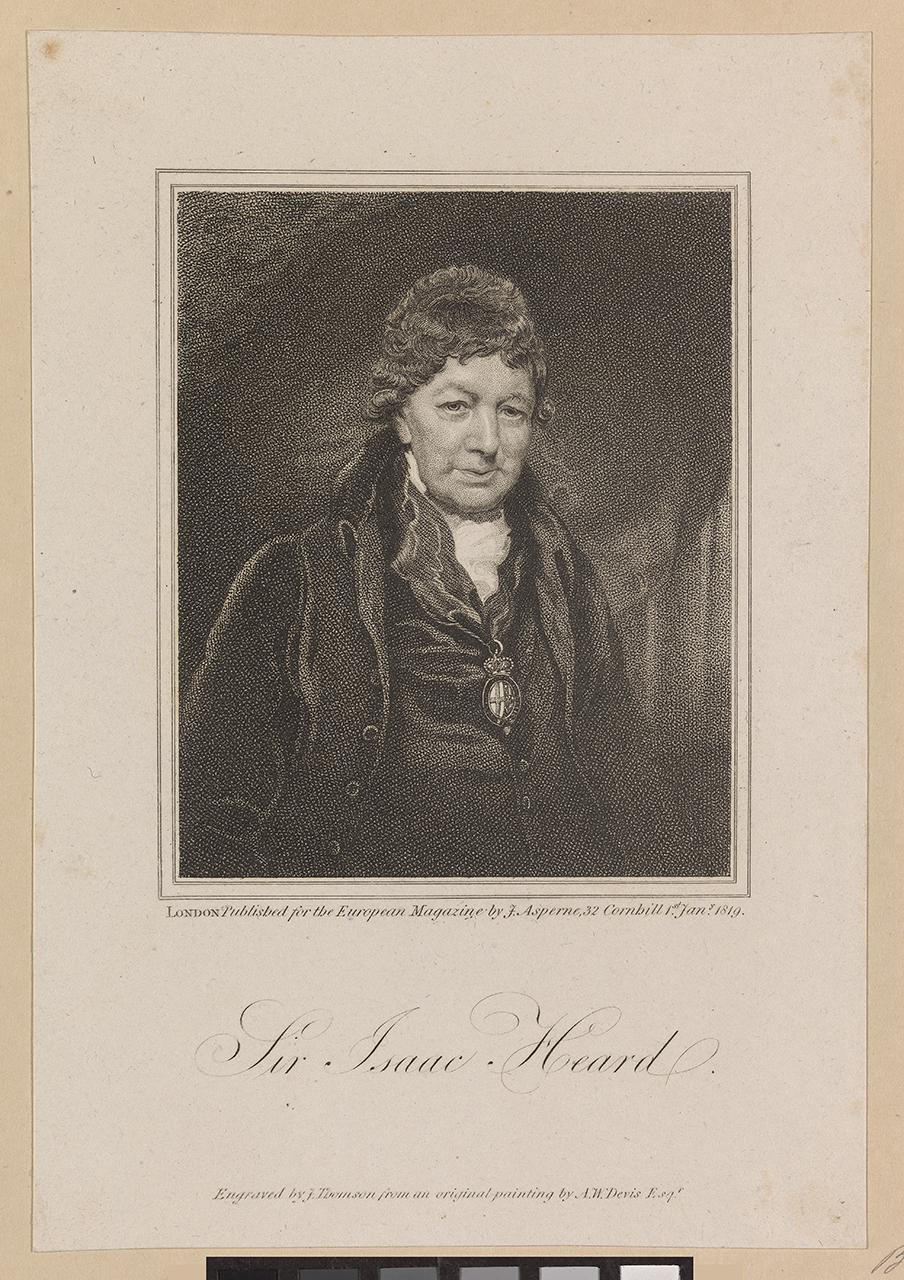
Isaac left the navy in 1751, seeing, in peacetime, little chance for career advancement. He became instead a merchant in Bilbao, Spain. In the course of his business he crossed the Atlantic several times, but the outbreak of the Seven Years War forced him to return to Britain in 1757, where he obtained employment as a merchant in London. His interest in history and antiquities led the Earl of Effingham (the Deputy Earl Marshall) to appoint him to the College of Arms in a junior position as Bluemantle Pursuivant of Arms in 1759. From here, he progressed to Lancaster Herald in 1761 and to Norroy Herald in 1774, later becoming Brunswick Herald and Clarenceux Herald (1780). Upon the death of the Garter King of Arms, Ralph Bigland, in 1784, Isaac was appointed to that office. He was knighted in 1786.
In 1797, Isaac granted Nelson his coat of arms. These bore the motto ‘Palman qui meruit ferat’ (‘let he who has earned it bear the palm’) and were in the style known as ‘landscape’, where the arms depict an event from the person’s life. Isaac was granted his own coat of arms in 1762, distinct from those of the rest of the Heard family. His arms, also in the landscape style, referred back to his near-drowning during his time serving in the Blandford and depict Neptune holding in his left hand the top of a ship’s mast. The motto Isaac adopted was ‘Naufragus in Portum’, which translates as ‘Shipwreck brought me into port’. The motto perhaps suggests that Isaac’s near-drowning did, after all, play a part in his pursuing a career on land, although it did not stop him making several trips to America and the European mainland.
Isaac remained vigorous and alert well into old age and only began to delegate some of his duties as Garter King of Arms in 1820. He reportedly possessed a keen memory and a cheerful disposition. Twice married and twice widowed, Isaac had no biological children but was close to his stepson Sir David Ochterlony. A few days after returning from a visit to Brighton, Isaac died at the College of Arms in London, aged 91. He is interred in St George’s Chapel, Windsor.
If you would like to find out more about Nelson’s funeral and Sir Isaac Heard, the Caird Library and Archive have a number of items which could help in your research, including:
- Fairburn’s edition of the funeral of Admiral Lord Nelson …, London: John Fairburn, 1806 (RMG ID: PBE9819)
- Gough, Richard. Gough: draft of letter from Richard Gough to Archdeacon Cheriton describing Nelson's funeral, 11 Jan 1806 (RMG ID: AGC/4/39)
- ‘Obituary. Sir Isaac Heard, Garter’, in Gentleman’s Magazine, 1st series 92/1, May 1822, pages 466-69 (RMG ID: PJA0735)